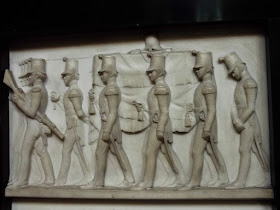Today (and yesterday) marks the 170th anniversary of the Battle of Ferozeshah (1845).
 |
| Jensi artillerymen |
After being reminded with a local newspaper article [Anniversary] and a recent [wargame show] today marks the 170th anniversary of the Battle of Ferozeshah. Full accounts of the battle can be found [here] and [here]. The battle marked the end of Sikh Raj in Punjab and the end of the first Sikh War. A number of Sikh colours were captured by the 80th Regiment of Foot (Staffordshire Volunteers) and were sent to Lichfield Cathedral. These flags usually (they are currently being restored) stand atop of the monument dedicated to the officiers and men of the 80th who died in Indian during the Sutlej campaign of 1845 and 1847.
 |
| Sikh Monument detail, Lichfield Cathedral |
An account of a young soldier (taken from "A Leicestershire Soldier in the Second Sikh War: Recollections of a Corporal of the 32nd Regiment of Foot in India 1848-49" by John Ryder) shows what high regard the British held for the men serving the Sikh artillery. He recorded:
"We drove them before us upon their own guns and works bayoneting the artillerymen at their posts. They were as good soldiers as ever took the field. They would not leave their guns and when the bayonet was through them they threw their arms round the guns and kissed them, and died."
These figures shown above represent Jensi artillery men. The particular figures are from Studio Miniatures 'Sikh Wars' range.
Using the forthcoming colonial 'The Men Who Would Be Kings' wargaming
rules (by Dan Mersey and published by Osprey) the Khalsa Army will provide a
very interesting alternative to the usual opposition faced by the British.
















































